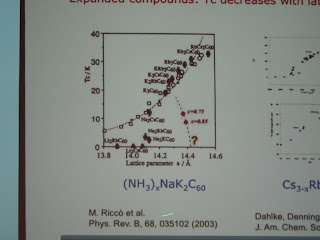Spin-Charge Gauge approach
Will use the strong coupling approach:
single occupancy constraint in the standard form, then introduce gauge particles (holons, spinons etc..)
Too many degrees of freedom: there is a gauge symmetry
First look at model with expanded dof, then fix with guage.
Slave boson approach: h boson, z_a fermion
so c_a = h*z_a is a fermion
But in 2D, there are more possibilities - can add fluxes to h and z
U(1) charge and SU(2) spin
with "statistical" compensation - so that c remains a fermion.
In other words, this is the gauge fixing: there is a huge sector of the SU(2) not allowed by U(1) compensation.
We can then start with h as a spinless fermion, then try to optimize these charge and spin fluxes (compatible with statistics) for whatever approximation scheme we use (here, Mean Field theory) Extra things to play with allow to e.g. optimize both t and J terms within the mean field.
In PG phase on 2D lattice, find charge U(1) pi-flux per plaquette works best, independent of doping up to a point.
Having optimized charge flux, look at the effects of the compatible SU(2) spin flux: basically, it attaches a spin vortex to the holon positions with opposite directions on the two sublattices. So the optimal spin flux gives short range AF.
Under doping, long range AF->short range AF via magnon formation by spinon binding.
A long wavelength treatment of the J-term in the MF gives a CP^1 NLsM with an additional term - which ultimately gives a spinon mass.
Metal Insulator crossover
What is origin of M-I crossover? The "obvious" explanation as 2D localization doesn't work - (k_F l) far from Ioffe-Regal limit.
Also, is M-I crossover with and without magnetic field the same phenomenon?
Calculation of conductivity: use Ioffe-Larkin formula R = R_h + R_s
But spinon and holon are bound by the gauge field - the contribution is decided by the slowest and not the fastest component. The holon can show metallic or insulating behavior depending on properties of the spinon: in fact, can even find that insulating behavior is compatible with a finite FS.
These effects give rise to the metal-insulator crossover - and can fit resistivity data very well, with no fitting parameters.
A new mechanism for Superconductivity
Proposed 3-step non-BCS mechanism for hole-doped underdoped cuprates.
a) Glue for SC comes from attraction between spin-vortices on different Neel sublattices - leading to incoherent holon pairs BCS-like at T_ph
b) A gauge attraction (originating from constraint) between spin and charge then induces at T_ps
c) Finally at some T_c the holes (holon-spinon bound pairs) condense, leading to superconductivity.
Some more details of this procedure:
Holon pairing: spin-vortices (which are bound to the holons) behave like a Coulomb gas. Introduce holons on left and right of MBZ, and there is a screening effect as not all vortices are paired. This gives a d-wave pairing OP, composed of two p-waves.
Nodons: Including the gauge fluctuations brings back the gauge invariance. This gives a slave-particle gauge field coupled by minimal substitution, known as the nodon.
Spinon pairing: Our physical particle excitations are the holes, not the holons; must work out how to dress the holons with spinons to get these back. Introduce a RVB-pair field, whose spectrum has a minimum at |k|=|\Delta^s| (c.f. roton minimum in liquid He due to backflow of vortices dressing the bare excitation). This eventually leads to some spinon pairing, breaking the global symmetry from SU(2) to Z_2 via the Anderson-Higgs mechanism. However for this to occur, need sufficiently large holon pair density - so this only occurs at finite doping.
In very simple terms however, the point is that the pairing of the spinons becomes easier because of the prior pairing of the holons.
Finally, one gets phase coherence - i.e. breaking of the global gauge symmetry (including the U(1) original physical one), i.e. this is finally superconductivity.
Summary
To revise: there are 4 characteristic temperatures:
Two crossover temperatures T_ph for holon pairing and T_ps for spinon-pairing
Phase transition T_c for full phase coherence
And another crossover temperature, T^* where the holon FS changes from large to small - which is the starting point of most of these calculations.
Good features of this mechanism for SC:
--Not simple BCS - also involves various crossover phenomena
--At T=0, SC appears at finite doping when doping is greater than the critical long range AF
--vortices allowed above TC, supporting Nernst signal and giving Fermi arcs, not nodes.
--Two positive branches in spinon dispersion which may give something like the hour-glass seen in neutron experiments.
Question (Piers): Can you write a Jastrow like wavefunction for your condensate?
Answer: No, not yet, and also not clear how much of this could possibly be seen in numerics.
There were some other questions, but I didn't quite catch them.















